MENUMENU
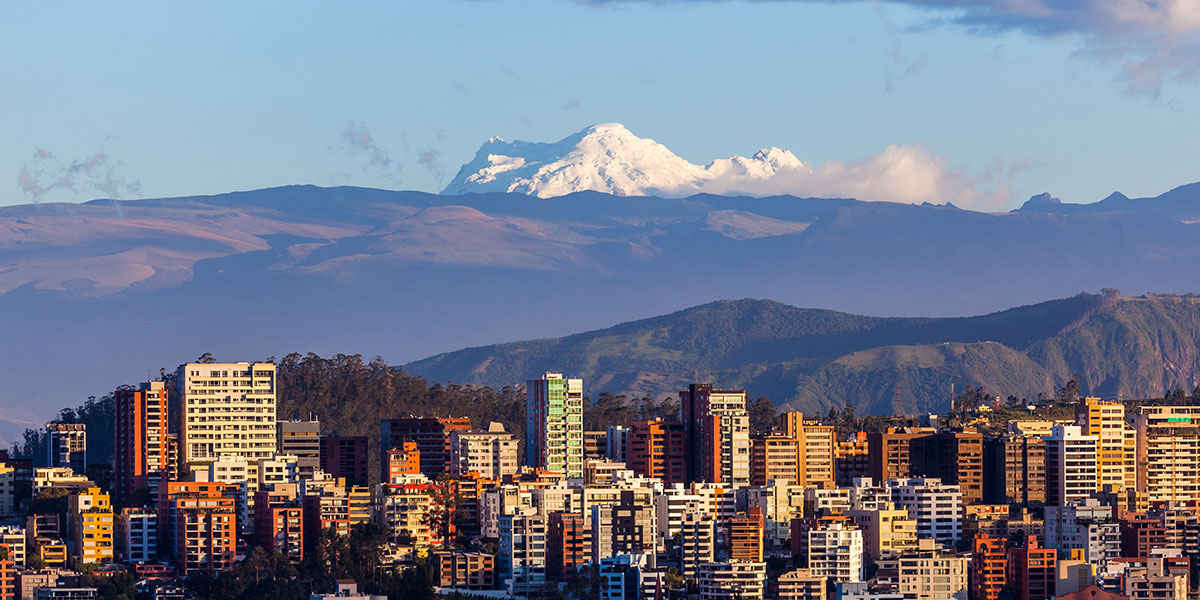
Reading time: 13 mins
Ecuador’s national parks are a testament to the country’s astounding natural diversity and cultural richness, offering a wide range of experiences for all types of travelers. From the awe-inspiring scenic beauty of Cotopaxi Volcano in Cotopaxi National Park to the unparalleled wildlife experiences found in the Galapagos Islands, there’s a National Park for just about every type of outdoor explorer.
In essence, Ecuador’s national parks are a testament to the country’s dedication to conservation and a call to explore and cherish the planet’s irreplaceable wonders. All of them provide access to the treasure trove of natural marvels that Ecuador harbors, and travelers would be wise to at least put one of them on their list of things to see and do throughout their visit. In this blog, we’ll provide you with the Top 10 National Parks in Ecuador you should consider checking out, listed in no particular order.
Appeals to: Hikers, Photographers, Mountain Bikers, Nature Enthusiasts
Distance from Quito: 1.5 hours by car
Cotopaxi National Park stands out among Ecuador’s top national parks, hosting a grand array of towering peaks and gorgeous plains. At its heart lies the iconic snow-covered Cotopaxi Volcano, one of the world’s highest active volcanoes and the second-highest peak in Ecuador, offering adventure seekers the thrill of a challenging ascent to the summit.
However, the park’s diverse ecosystems also lend themselves to more casual hikers, landscape photographers, and mountain bikers. From high-altitude paramo (Spanish for highlands) to serene moorlands and patches of forest, visitors will get to traverse these areas while having opportunities to spot elusive Andean condors and majestic wild horses.
Its proximity to Quito, Ecuador’s capital, makes it a convenient day trip or weekend getaway, with several unique stays at haciendas or unique hotels in the area. Its cultural significance, too, allows visitors to admire a revered and iconic volcano for the indigenous communities of Ecuador (Cotopaxi stands for “neck of the moon” in Quechua). Without a doubt, Cotopaxi National Park promises an unforgettable blend of natural beauty, outdoor adventures, and a dash of cultural insight for all types of travelers looking to explore Ecuador’s top national parks.
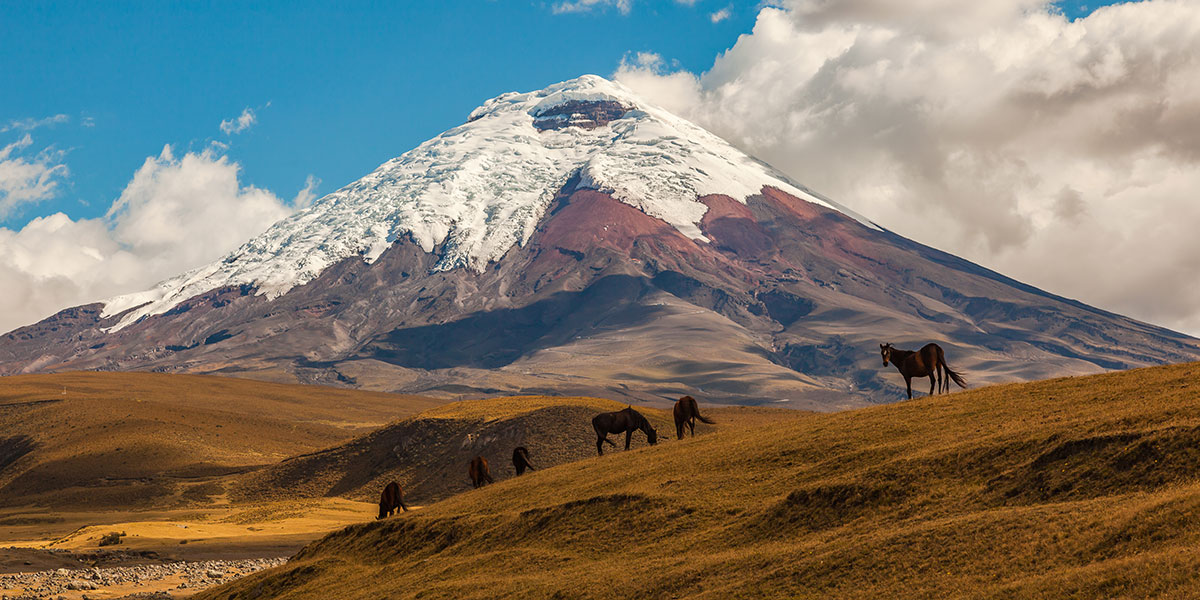
Ecuador National Park: Cotopaxi
Appeals to: Climbers, Hikers, Photographers, Nature Enthusiasts
Distance from Quito: 1-1.5 hours by car
Cayambe National Park is a fantastic place to visit, heralding a spot among Ecuador’s top national parks due to its striking scenic beauty, which is accessible to adventurers of all types. This park showcases the majestic Cayambe Volcano, a dormant stratovolcano with a permanent glacier, offering a stunning backdrop for outdoor enthusiasts, climbers, hikers, and photographers. The park’s diverse landscapes—which range from high-altitude paramo to pristine forests—all provide a habitat for unique flora and fauna to flourish, making it a paradise for nature lovers and wildlife enthusiasts.
Bear in mind that this National Park of Ecuador is massive, spanning nearly 1 million acres (around 400,000 hectares). It’s so big that it has three separate entrances, the two most popular of which are found in a.) unsurprisingly the namesake town of Cayambe and b.) near the hot springs of Papallacta, both of which aren’t far from Quito. But be aware that these two entrances offer radically different perspectives of the National Park—the latter is a spectacular, lush, and verdant valley that’s perfect for casual hikers and those looking to relax, while the former is apt for those looking to get up close and personal with the snow-covered Cayambe Volcano in the form of climbing, mountaineering, and photography.
For adventure seekers, Cayambe National Park offers exceptional opportunities for hiking and mountaineering, with Cayambe Volcano being a prominent attraction. The park’s serene lakes, such as Lake Piñan, add to its natural charm and provide serene spots for relaxation and photography. With its proximity to Quito, Cayambe National Park is easily accessible for day trips or longer explorations, making it a must-visit destination for travelers looking to immerse themselves in Ecuador’s breathtaking landscapes and outdoor adventures.
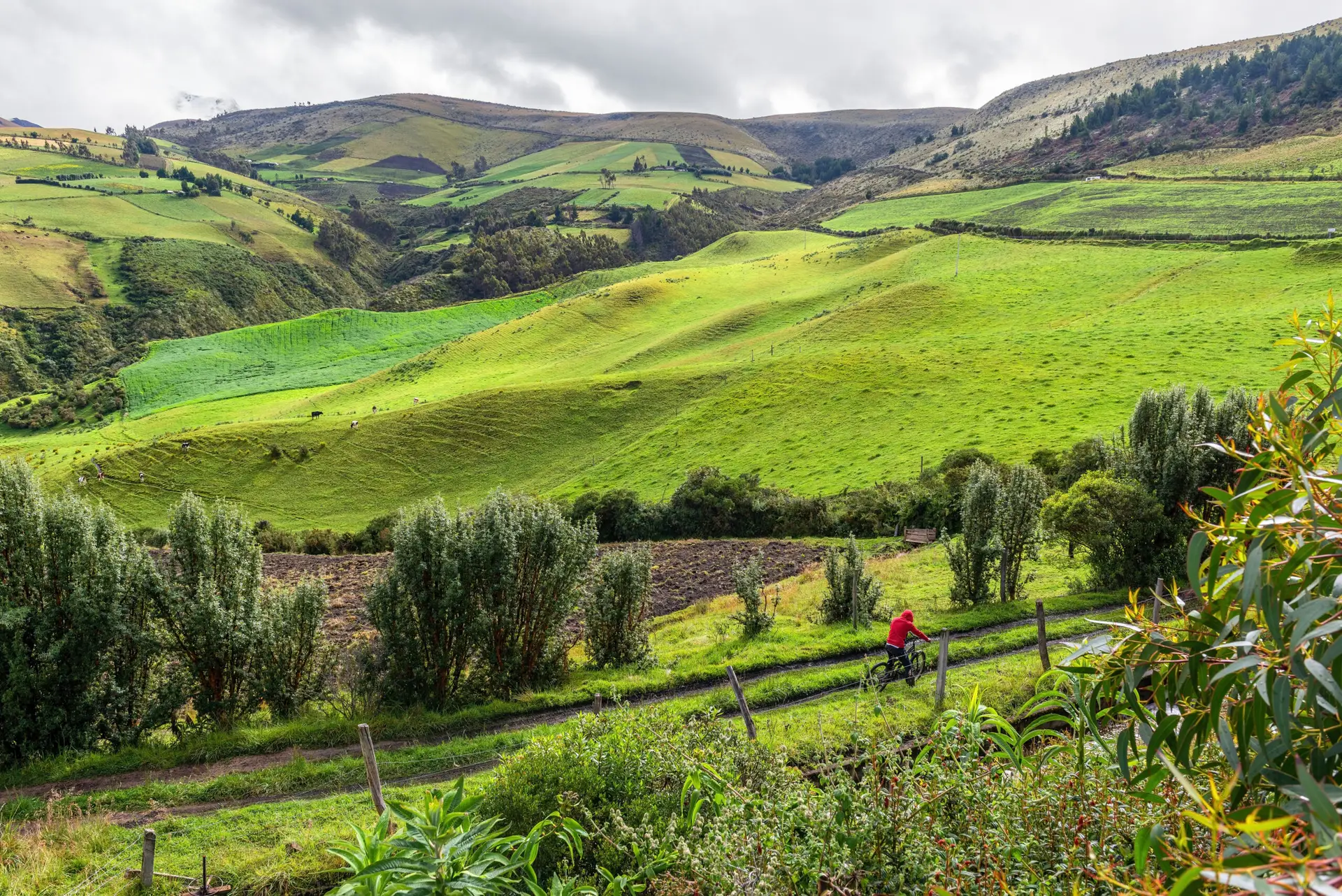
Cayambe National Park
Distance from Quito: 45 minutes (via plane) or 8-10 hours (via car or bus, transfer in the city of Coca)
Appeals to: Nature Enthusiasts, Wildlife Watchers, Photographers
Yasuni National Park stands out as a jewel among Ecuador’s natural wonders and National Parks, boasting its status as one of the world’s most biodiverse sanctuaries. This Amazonian paradise, sprawled across 2.4 million acres (roughly 970,000 hectares) in the Pastaza and Orellana provinces near Quito, is a haven for nature lovers and wildlife aficionados. With its lush rainforest canvas, the park is a vibrant mosaic of exotic birds, skittering monkeys, rare and elusive jaguars, and a symphony of other wildlife, including pink dolphins and giant otters. The rich tapestry of life here is further enriched by the presence of indigenous communities such as the Waorani and Kichwa, weaving cultural depth into the park’s natural splendor.
Yasuni’s accessibility is facilitated from Coca by plane or boat, offering an embarkation point into the heart of the National Park. The park’s lodges serve as gateways to immerse yourself in wildlife observation experiences, blending river voyages with treks through the verdant undergrowth. Visitors are strongly encouraged to traverse these lands with a certified naturalist guide, ensuring a journey that is as informative as it is safe. This is especially pertinent given the park’s distinction as a realm of jaguars and a sanctuary for uncontacted tribes.
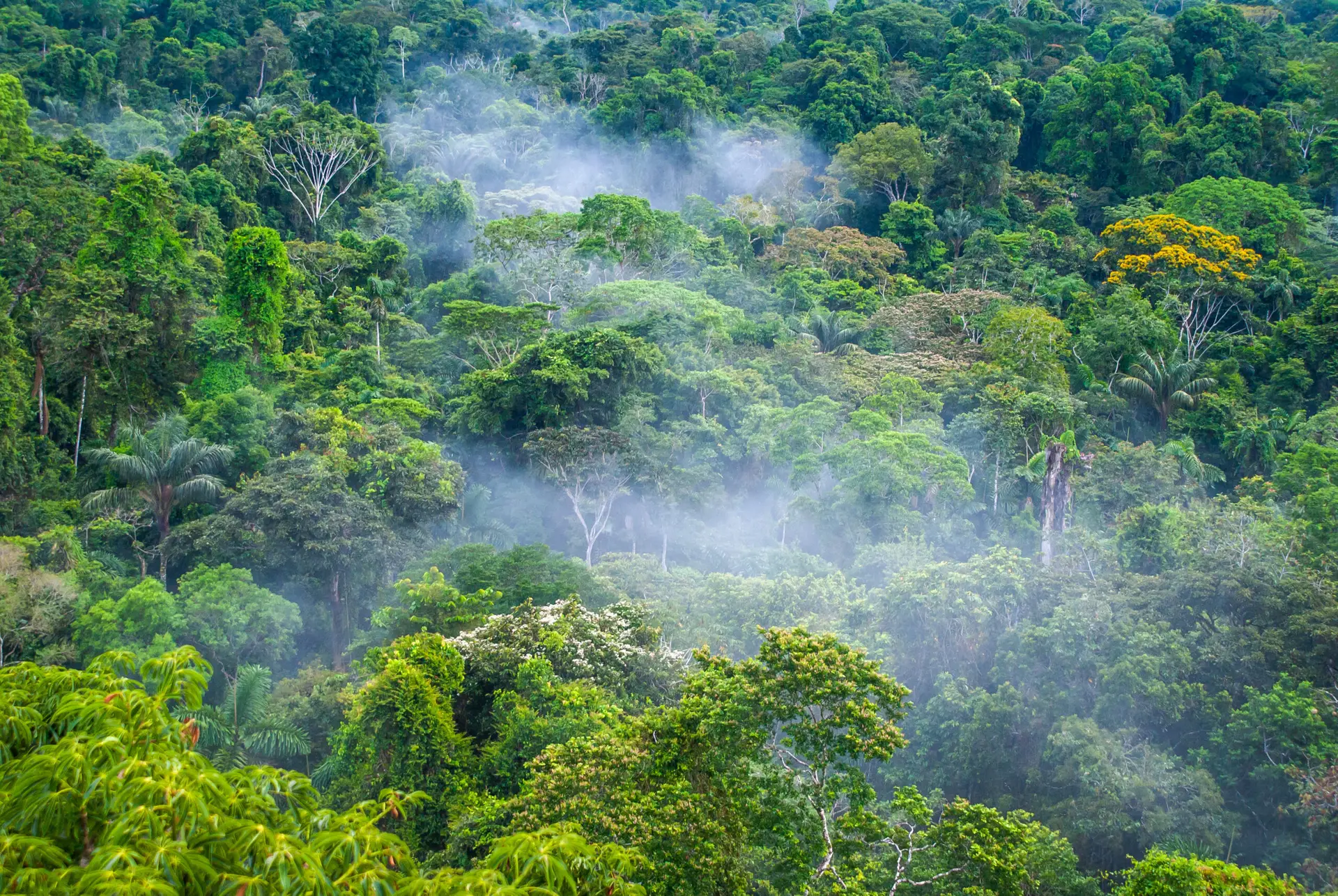
Beautiful landscape of the amazon rainforest, Yasuni National Park, Ecuador
Appeals to: Birdwatchers, Hikers, Nature Enthusiasts, Adventure Seekers, Photographers, Eco-tourists
Podocarpus National Park in Ecuador is full of natural wonders, often cherished for its rich biodiversity and unique ecosystems. Nestled in the southern Andes, within the Loja and Zamora provinces, this park covers an expansive area of around 560 square miles (approximately 1,460 square kilometers). It’s a sanctuary not just for nature lovers but also for those fascinated by the intricacies of ecological systems and the beauty of untouched landscapes. The park’s diverse terrain, ranging from cloud forests and high Andean paramo to montane forests, hosts over 4,000 plant species, of which 40% are endemic, showcasing the incredible diversity of flora. Meanwhile, for birdwatchers, it’s an absolute paradise, offering the chance to spot over 600 bird species, including hummingbirds and toucans, amidst the lush vegetation.
Podocarpus National Park is distinguished by its two main access points: one near the city of Loja, offering short hikes for a quick immersion into its native flora and fauna, and another near the town of Zamora, characterized by a warmer climate and distinct plant and animal life. The park’s vast landscapes include pristine lakes, waterfalls, and the Podocarpus trees, which give the park its name. These trees, which are a part of Ecuador’s only native species of conifers, add to the park’s unique biodiversity and magic. With its proximity to the aforementioned local cities, Podocarpus is conveniently accessible for day trips and extended explorations, making it an essential destination for travelers aiming to delve into the southern Andes’ captivating landscapes and biodiversity.
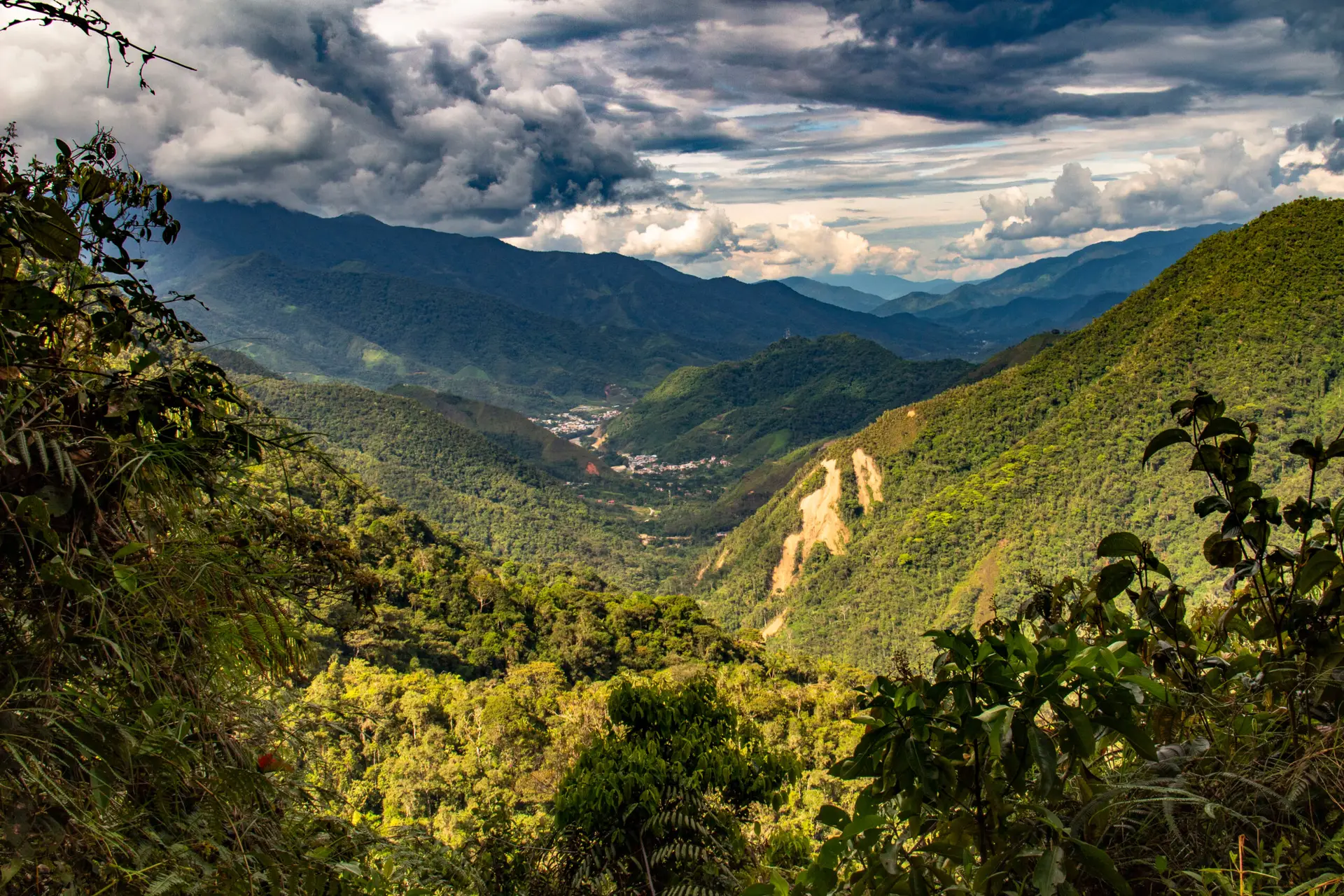
Podocarpus National Park in Ecuador
Appeals to: Hikers, Adventure Seekers, Wildlife Watchers, Photographers, Nature Enthusiasts
Cajas National Park, nestled in the highlands of Ecuador’s Azuay Province and not far from the beautiful city of Cuenca, showcases diverse natural landscapes and rich cultural history. Encompassing an area characterized by rugged terrain, vast paramo grasslands, and over 700 glacial lakes and lagoons, Cajas is a paradise for those who seek the wonder of the outdoors and the serenity of nature.
Its myriad of trails offers visitors the chance to explore a variety of ecosystems, from cloud forests to rocky hills and mountains, each providing a unique experience that pairs profound solitude and wilderness. The dramatic vistas of Cajas, with its cold, crystal-clear lakes and the ever-changing sky, are a photographer’s dream, offering awe-inspiring landscapes at every turn.
Wildlife in Cajas is as diverse as its habitats. The park is home to an array of species that have adapted to its cold, high-altitude environment. Spectacled bears, Andean foxes, and many bird species, including the emblematic Andean condor, can be found here, making it a hotspot for wildlife observation.
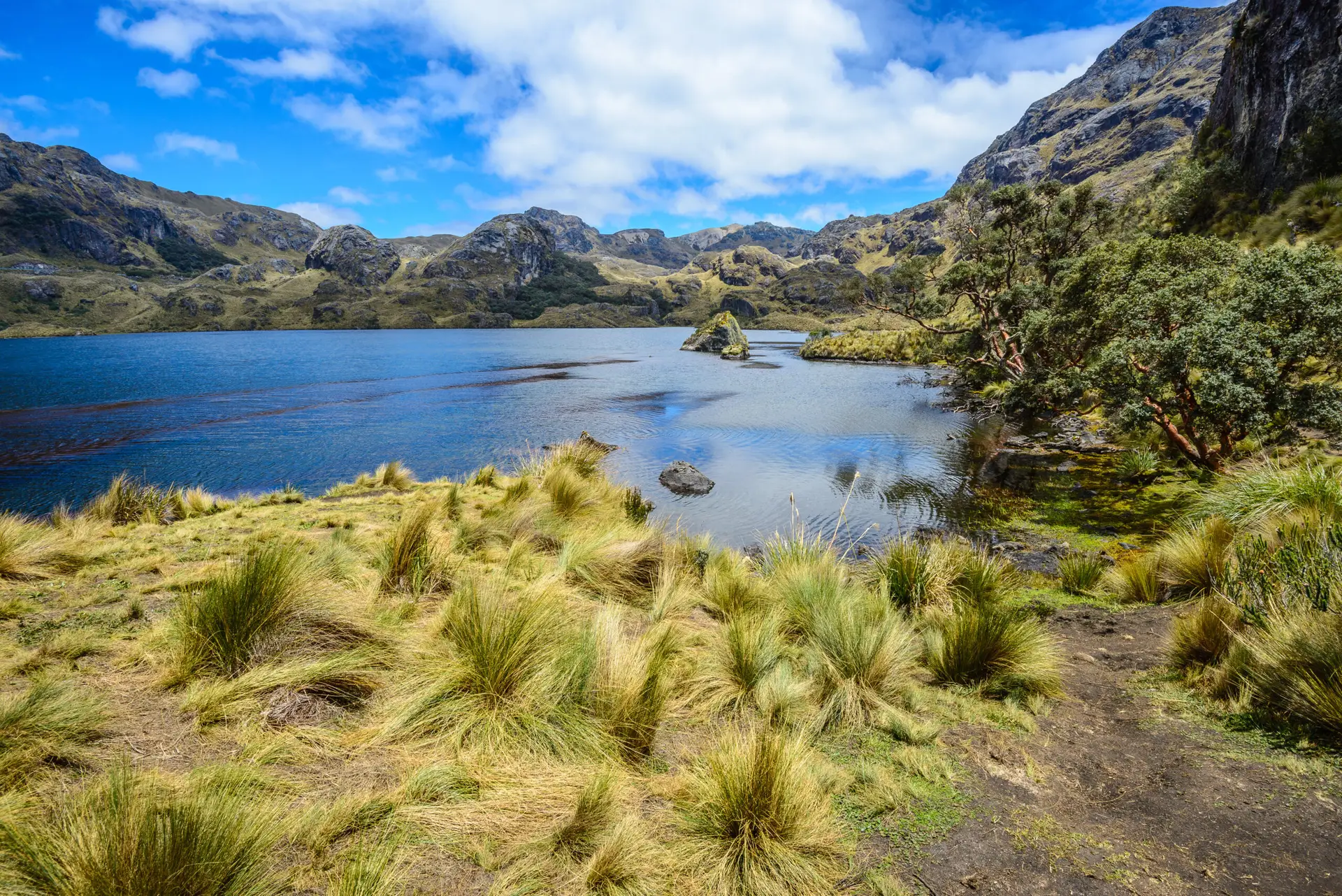
Cajas National Park
Appeals to: Wildlife Watchers, Nature Enthusiasts, Geology Aficionados, Photographers, Aquatic Adventurers, History Buffs
Sitting among the top 10 national parks in the world and one of the first areas in Ecuador to be designated as a National Park, the Galapagos Islands stands out as a true marvel of nature, wildlife, and preservation. Renowned for its unparalleled biodiversity that features unique and endemic species found nowhere else on Earth, such as giant tortoises, marine iguanas, penguins (north of the equator), flightless cormorants, and blue-footed boobies.
This pristine National Park offers exceptional opportunities for wildlife encounters with completely docile creatures that—due to having evolved in an environment virtually free of human interference—are fearless (and even curious!) in the presence of humans. Its pristine beaches, crystal-clear waters, and volcanic landscapes create a natural wonderland for explorers and photographers alike.
In addition to this, the archipelago has been designated a World Heritage Site by UNESCO and a Marine Reserve, the latter of which makes it an ideal place to visit if you’re looking to snorkel, SCUBA dive, kayak, paddleboard, and/or surf. And don’t forget: This is where Charles Darwin developed his groundbreaking theory of evolution, so history aficionados can unravel the story behind his footsteps throughout the archipelago!
Guided tours, along with eco-friendly practices and regulations, ensure the preservation of this delicate ecosystem, making the Galapagos National Park a must-visit destination for travelers seeking peace of mind in an unforgettable adventure and a chance to witness the evolutionary wonders of the Galapagos Islands in Ecuador.
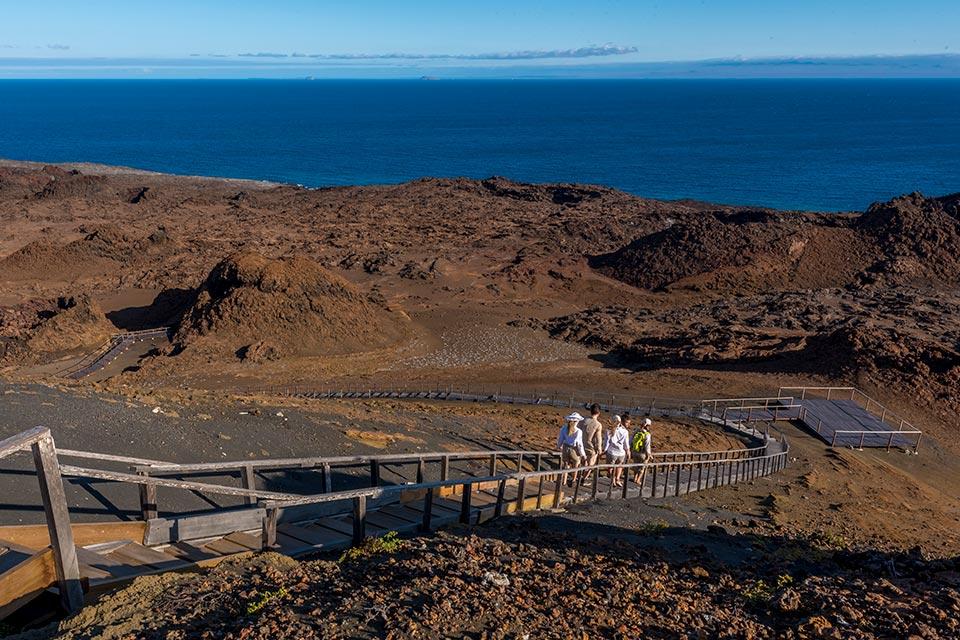
Ecuador National Park: Galapagos Islands
Appeals to: Hikers, Volcano Enthusiasts, Wildlife Watchers, Nature Enthusiasts, Adventure Seekers
Sangay National Park, positioned majestically within the Andes Mountains and sprawling across the provinces of Tungurahua, Chimborazo, Cañar, Azuay, and Morona Santiago, stands as a testament to the raw and rugged beauty of Ecuador’s natural landscapes. Covering nearly 2,000 square miles (approx. 5,200 sq. km.), it’s celebrated as one of Ecuador’s largest protected areas, offering a sanctuary to a myriad of species and diverse ecosystems, from tropical rainforests to high-altitude glaciers.
The park’s dramatic elevation range, from 900 meters to 5,319 meters above sea level, fosters an extraordinary variety of flora and fauna, providing habitats for endangered species such as the spectacled bear, mountain tapir, and Andean condor. The allure of Sangay extends beyond its wildlife; it encompasses three active volcanoes, including the park’s namesake, Sangay Volcano, and Tungurahua—both of which contribute to the park’s dynamic landscape (think: high-altitude volcanoes in the middle of dense jungle) and offer unique opportunities for adventure and exploration.
For those drawn to the thrill of the outdoors, Sangay offers well-maintained trails and accessible entry points, particularly near the spa town of Baños de Agua Santa, where hikers can venture close to the puffing Tungurahua Volcano.
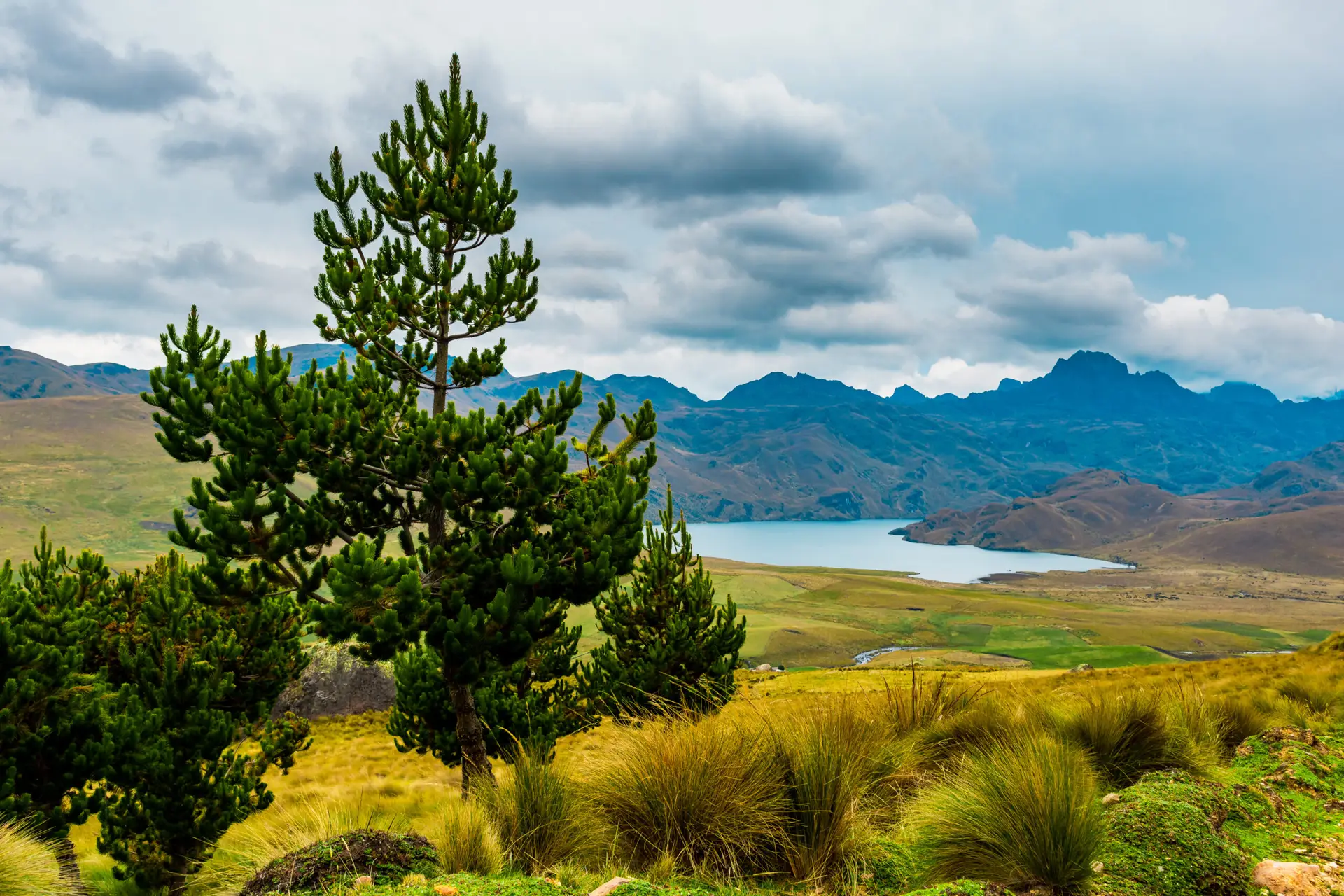
Sangay National Park
Appeals to: Beach Lovers, Nature Enthusiasts, Hikers, Wildlife Watchers, Divers
Machalilla National Park, nestled along the scenic Pacific coast in Manabi province, stands out as an accessible and captivating highlight within Ecuador’s array of natural treasures. This coastal sanctuary offers a diverse array of landscapes, from serene beaches and crystal-clear waters to dense tropical and dry forests, appealing to a wide spectrum of travelers seeking the beauty and adventure of Ecuador’s shores.
Renowned for its ecological diversity and cultural heritage, Machalilla encompasses not only terrestrial wonders but also maritime marvels, including the famed Isla de la Plata. Often dubbed the “Poor Man’s Galapagos,” Isla de la Plata is a beacon for those wishing to observe unique wildlife like blue-footed boobies, frigatebirds, and humpback whales during their migratory season without the Galapagos price tag.
The biodiversity of Machalilla is a big draw for wildlife enthusiasts, housing over 270 species of birds, various species of monkeys, and a plethora of marine life, making it an ideal spot for birdwatching, snorkeling, and scuba diving.
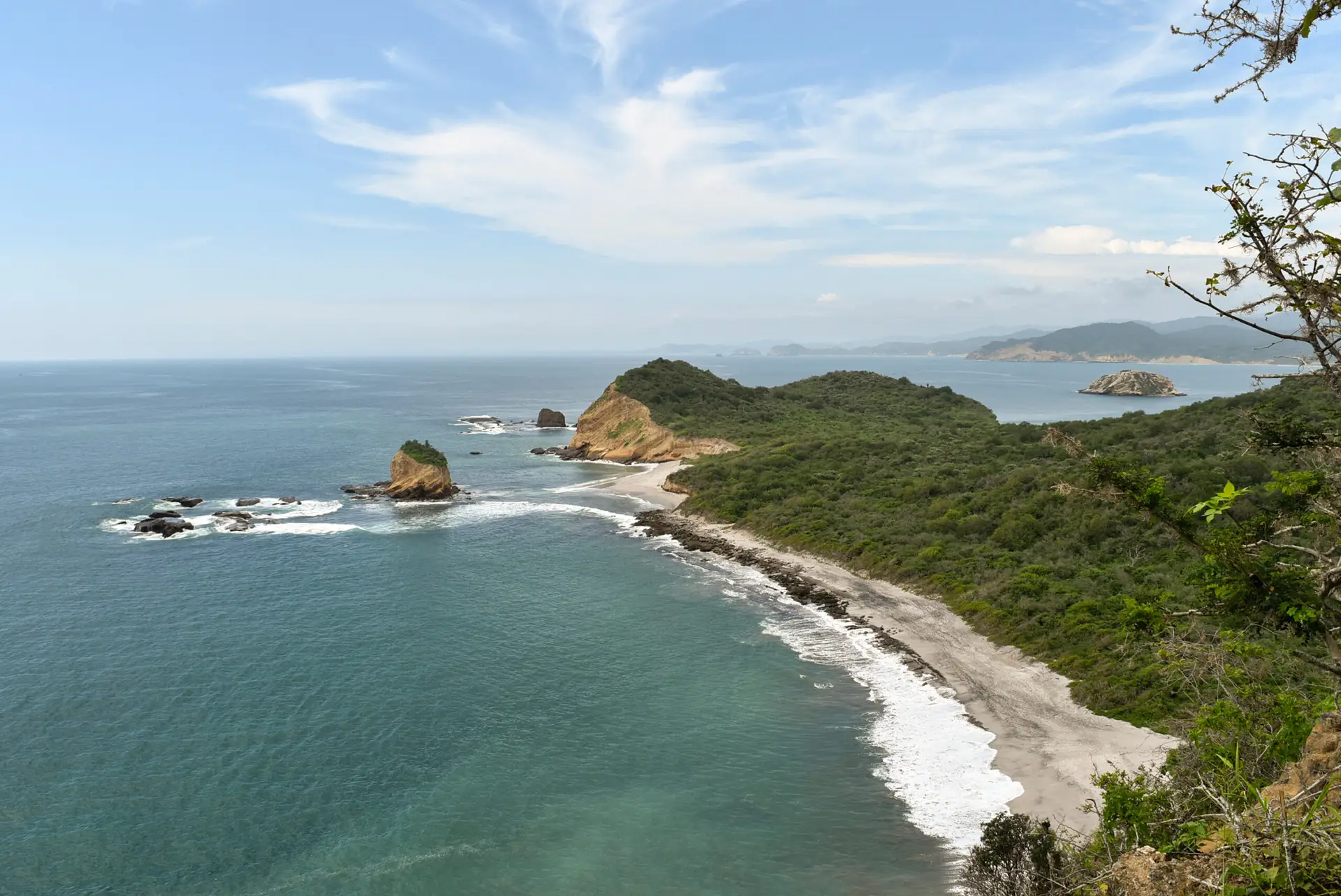
Machalilla National Park, Ecuador
Appeals to: Nature Enthusiasts, Hikers, Wildlife Watchers, Adventure Seekers, Birdwatchers, Photographers, Eco-tourists
Sumaco Napo-Galeras National Park, nestled within the heart of northeastern Ecuador and spanning the provinces of Napo, Orellana, and Sucumbios, stands as a beacon of natural beauty and untouched wilderness in the Amazon Rainforest. This significant protected area, home to the majestic Sumaco Volcano, Pan de Azucar, and Napo Galeras mountain peaks, offers a sanctuary for those seeking the thrill of exploration and the serenity of nature’s untouched landscapes.
The park’s vast and diverse ecosystems, from dense rainforests and cloud forests to rushing rivers, create a haven for an astonishing variety of flora and fauna. It’s a realm where the elusive jaguar, puma, and tapir roam freely and where birdwatchers can revel in the sight of numerous bird species, making it a paradise for biodiversity enthusiasts.
Sumaco National Park’s rugged and mysterious beauty, combined with its relatively unexplored terrain, invites adventure seekers to rafting, hiking, and mountain climbing. The park’s remote wilderness makes it an ideal destination for those yearning for an authentic Amazon adventure, with accessibility from nearby Amazonian towns like Tena enhancing its appeal.
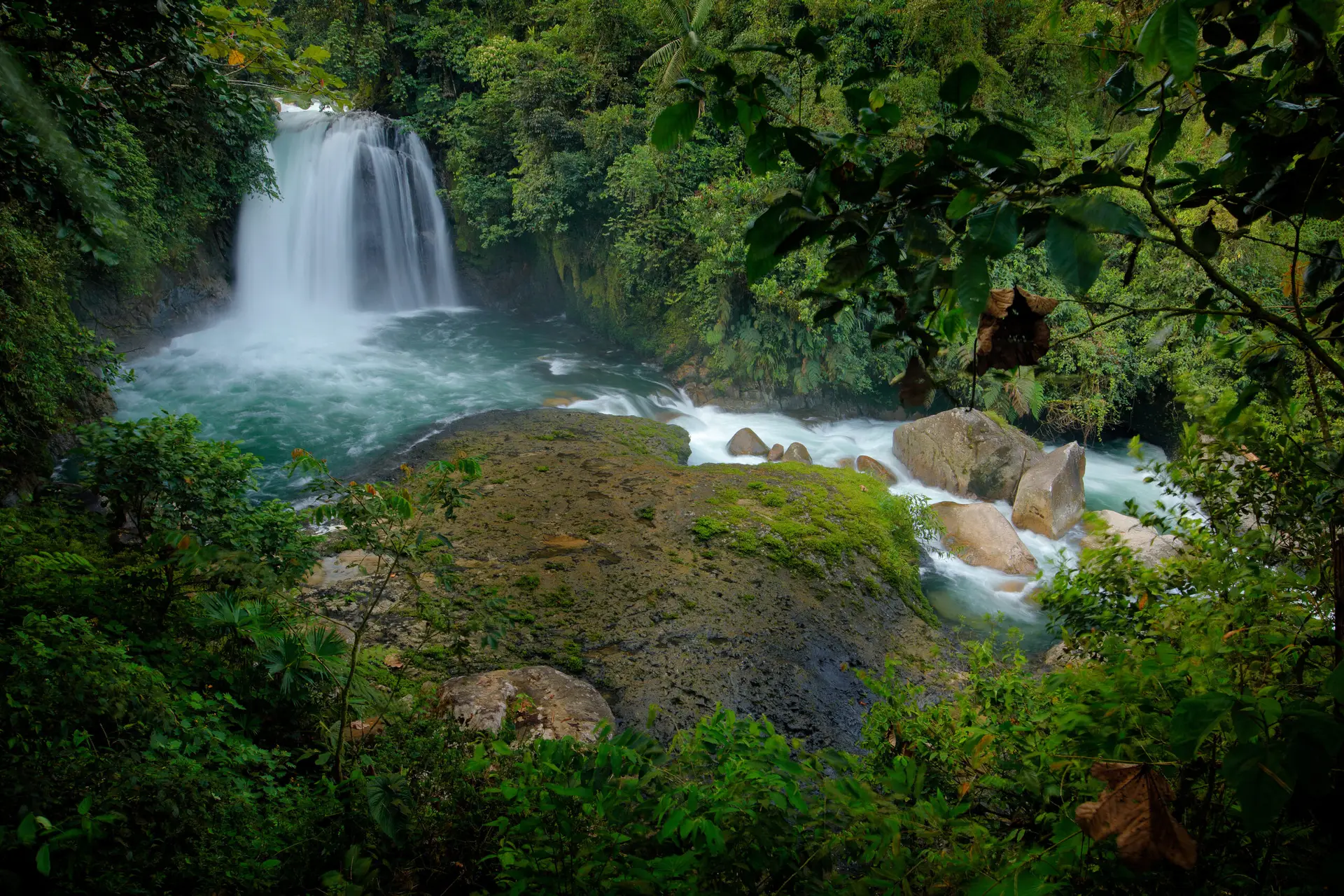
Stunning waterfall in Sumaco National Park
Appeals to: Hikers, Adventure Seekers, Wildlife Watchers, Photographers, Nature Enthusiasts, History Buffs
Llanganates National Park, sprawled across the provinces of Cotopaxi, Napo, Tungurahua, and Pastaza, stands as a bastion of Ecuador’s immense natural wealth and historical allure. This park, cradled in the eastern Andes, is a haven of biodiversity, featuring cloud forests, high-altitude paramos, serene lagoons, and diverse wildlife, making it a magnet for nature lovers and adventurers alike.
Renowned for its rugged landscapes that include an array of stunning lakes, rivers, and mountains, Llanganates offers a plethora of activities for the outdoor enthusiast, from hiking and horseback riding to camping and mountain climbing. The park’s rich ecosystems are home to various species, such as spectacled bears, pumas, and an impressive assortment of birdlife, providing endless opportunities for wildlife observation and photography.
Beyond its natural beauty, Llanganates is enveloped in the mystique of the “Treasure of the Llanganates,” a legendary trove said to be hidden by the Incas within the park’s mist-shrouded peaks. This blend of breathtaking scenery and enigmatic history makes Llanganates a unique destination for those intrigued by the prospect of adventure and historic cultural exploration.
Accessible from nearby towns such as Baños and Tena, Llanganates National Park not only promises the discovery of Ecuador’s rich biodiversity and striking landscapes but also an immersive journey into the heart of Andean legends.
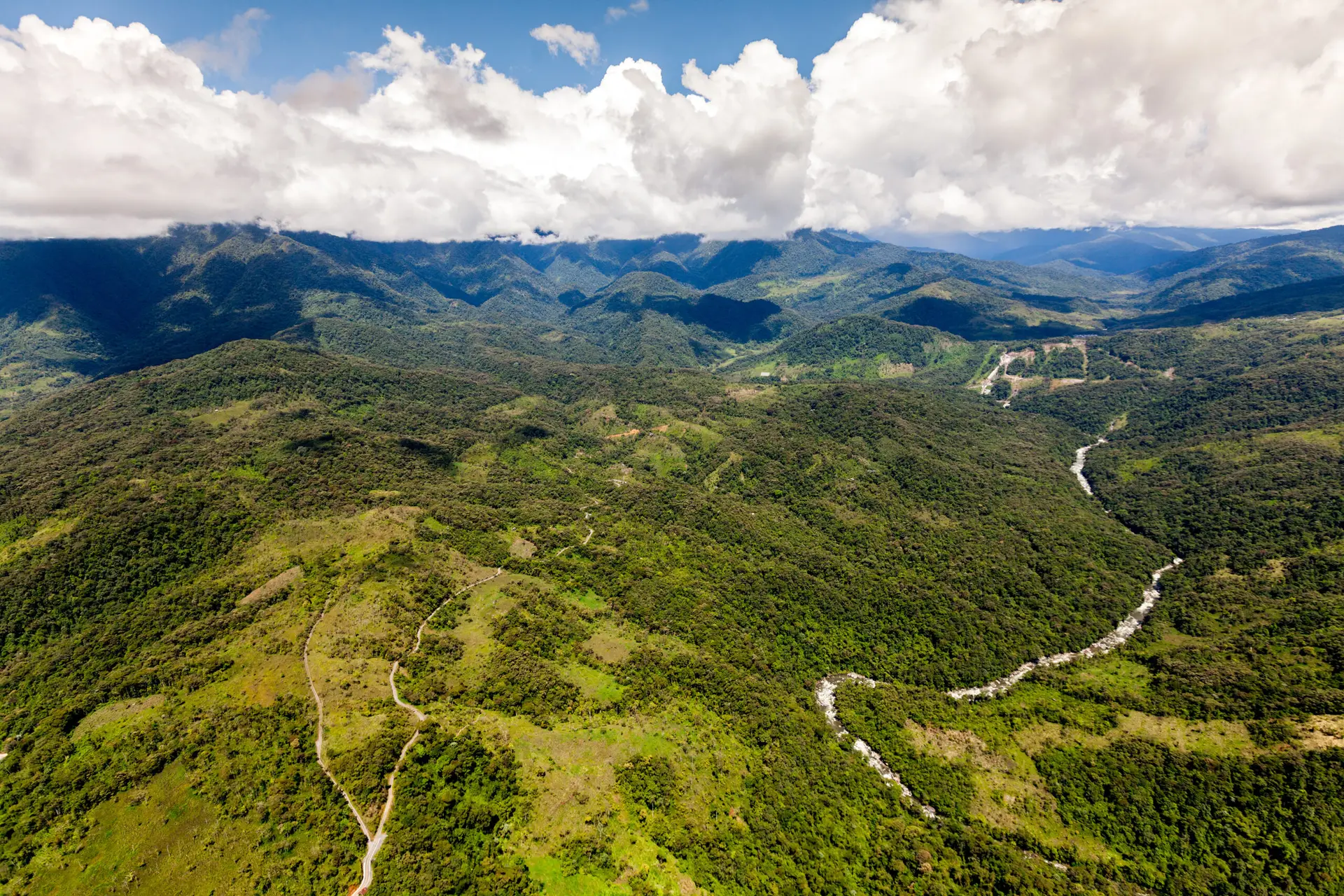
Llanganates National Park
Ecuador’s National Parks encapsulate the heart of the country’s extraordinary natural beauty and ecological diversity. Each park offers a unique journey into landscapes that range from towering volcanoes to dense Amazonian forests, providing endless opportunities for adventure, wildlife observation, and cultural immersion. These protected areas are not just outdoor destinations; they are sanctuaries and a testament to the preservation efforts that have helped maintain the essence of Ecuador’s rich environmental and cultural heritage. As adventurers and nature enthusiasts explore these vibrant ecosystems, they’re invited to connect with nature’s magnificence and some of the ancient traditions and history that honor these lands.